
ONTARIO

Fort Erie
NO PART OF THE FOLLOWING
ARTICLE AND PHOTOGRAPHS
MAY BE REPRODUCED WITHOUT
PERMISSION FROM THE AUTHOR ©
Also known as
Snake Hill Grove and Fort Erie Grove.
This park started as did many in Canada, as a picnic ground. It was originally called "Snake Hill Grove" and was situated in a nice plot of trees next to the waters of Lake Erie about 10 or 15 kilometers east of Crystal Beach by air. The name "Snake Hill" came from a little mound of earth between the park and the Old Fort, which American forces attacked during the war of 1812. The fort would remain in ruins until the 1920s.
The park was founded by Benjamin & Edwin Baxter and W.B. Pierce. Besides catering to Canadians, Erie Beach was advertised to Americans in Buffalo as an encouragement to get away from the city for a break. An outing to Erie Beach began with a trip on the Fort Erie ferry, with passengers transferring to The Fort Erie, Snake Hill Pacific Railroad to arrive at the grove. This service began in 1887 and the train affectionately became known as "The Sandfly Express". The official name of the company was "The Fort Erie Ferry Terminal Railway Company" and was owned by the Baxters and Pierce.
|
Ferry Landing at Fort Erie Circa 19-0s 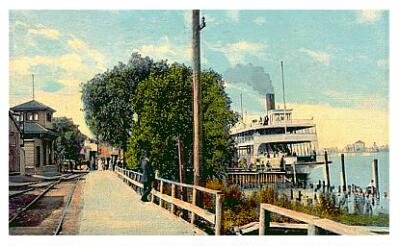
|
| This is the transfer point between the ferry and rail service to the park. |
The first Sandfly Express engine, known as "Old Eunice", was built in 1885 in Pittsburgh at either The Pittsburgh Locomotive Company or H.K.Porter Company. The rolling stock, however, was manufactured by Ontario Car Company in London Ontario and consisted of four open coaches. It was replaced after a few years with a saddleback-boiler style Baldwin locomotive, known as "Number 29". That engine ran until 1902 when it derailed and hit a tree.
1901 was the year of the Pan-American Exposition in Buffalo.(*) The impressive rides and attractions at this world's fair were not lost on Fred Weber because he had just bought Snake Hill Grove. He changed the name to Fort Erie Grove and proceeded to upgrade the facilities over the next decade. In fact, Weber bought the miniature train from the Exposition after that fair finished its run.
Another item added was in 1904. It was an Armitage-Herschell Company carousel model called "Flying Ponies", only three of which were ever made. The horses were suspended from an articulated overhead pole that locked into a ring inside each horse's body so that neither the horse nor the pole touched the platform. This pole passed through the body via the back of the neck, hidden behind a high mane. As the ride turned, the ponies "flew" out via centripetal force. (One of the ponies currently resides at the Herschell Carrousel Factory Museum in North Tonawanda, New York. An Erie Beach ride ticket was discovered inside its body during restoration.)
When New York City first began to discontinue its elevated steam railway in favour of an electric subway, Weber purchased some of the rolling stock in 1901. He ran a new train on the Fort Erie, Snake Hill & Pacific Railroad from the Fort Erie ferry dock to the park. A second pair of locomotives and cars also came from The Manhattan Elevated Railway after steam was outlawed in New York City in 1903. In 1904, engine #271 began service. It would operate until the park closed in 1930.
|
Erie Beach Midway Entrance Circa 19-0s 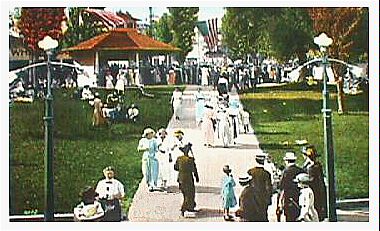
|
Here is the entrance to the midway at the park. Note the American Flags. This was probably taken on their Fourth of July holiday. Canadian parks close to the U.S. border would often promote the holiday to entice cross-border patronship. |
Along the lakeshore was created a 1200-meter concrete walkway for the use of the up-to 20,000 patrons that flocked to the park on summer weekends.
|
Beach Promenade Circa 1910s |
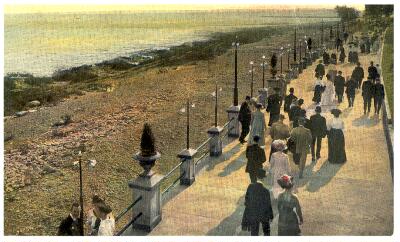
|
These and other improvements such as the Lighthouse Slide increased patronage to the point that the 65-room Erie Beach Hotel was built in 1905, turning day trips into overnight ones and making the park a small resort. (The Lighthouse Slide was likely a dry slide - see Maple Leaf Village Amusement Park for photos of what is likely the same model.)
One major improvement made under Weber's ownership was the installation of a "Figure 8" roller coaster. Previous sources had indicated an installation year of 1909 and a possibility that it had come from Crystal Beach Park. Crystal Beach built The "Backety-Back" for 1909 and one source had implied the "Figure 8" was then sold to Erie Beach.
|
Figure 8
Circa 1908 or 09 
|
|
This ride ran single, four-person cars.
One of them is seen on the lift hill. |
However, research seems to indicate this to be wrong. 1909 seems too late for construction of a new "Figure 8" coaster. Most were built in the late 1800s through to about the mid 19-0s. By then, bigger thrills were being sought by patrons used to the gentle dips of the typical "Figure 8" ride. It seems that the Erie Beach coaster may have been built as early as 1901, which fits the timeline of that model. As well, the Crystal Beach "Figure 8" was advertised for the 1910 season and sources indicate it may have been in that park until 1915 when construction of The "Giant" was begun. This indicates that the ride was not sold to Erie Beach. Realise too, that both parks being within 15 kilometres of each other by air, were in fierce competition, so it seems unlikely that either park would sell anything to the other, even something used.
In addition, a park map of Erie Beach for 1910 shows only one roller coaster and it's labelled as "Scenic Railway". Now, in those days, it was not uncommon to call all roller coasters by that name. However, an actual "Scenic Railway" was built by John Miller around that time and so the conclusion is that the Miller ride replaced the "Figure 8". This may be the case because the photograph of the Erie Beach midway below shows a coaster that appears to be The "Scenic Railway" located to the right of the stadium entrance where The "Figure 8" may have been.
|
Midway
Circa 1910s 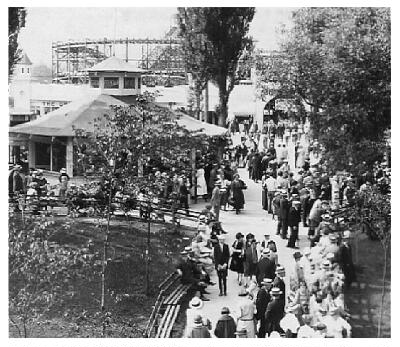
|
|
The coaster at Upper Left appears
to be The Scenic Railway.
It's to the left of the stadium
entrance, seen through the tress
at the right. Note the lighthouse structure at Upper Left. Presumably, this is theming for the Lighthouse Slide. The structure in its right foreground appears to be a carousel building. |
Given this photo, and coupled with coaster sources suggesting the Miller "Scenic Railway" as having opened in 1911, not 1910, a conclusion is that the map's "Scenic Railway" might actually be the "Figure 8" ride and that a second coaster, an actual "Scenic Railway", opened the year after the map and on the same spot. So either the date for the map, or for one or both coasters, is wrong, or both coasters existed in 1911. Given all this, it tentatively seems that the "Figure 8" ran from around 1901 to the end of the 1909 or 1910 season and was then replaced with a "Scenic Railway" in 1910 or 1911.
|
Update! Victor Canfield of Hershey, Pennsylvania researched a newspaper archive and says: "There isn't reliable coverage before 1909, but a new `Scenic Railway/Giant' coaster is mentioned in 1910. Generally, only a single coaster is mentioned at a time (`Scenic Railway' 1912; `Figure Eight' 1913; $15,000 `Scenic Railway' 1916), but there is one 1915 mention of both `Scenic Railway' and `Figure 8'. It's a bit hard to interpret -- many U.S. coasters were indiscriminately called `Figure Eight' or `Scenic Railway'." This raises more questions rather than answers the ones given earlier in this article. Regardless, taking in all information, a new coaster was built in 1910 and appears to be the "Scenic Railway", and the $15,000 reference in 1916 is likely for the same ride. The fact that there is a 1913 reference to a "Figure Eight" leads to the speculation that that ride was moved and continued to run elsewhere in the park, especially given the 1915 mention of both rides found by Victor. However, it's odd that the 1910 map only mentions the one ride if The "Figure 8" was actually kept but moved to another location in the park. |
The grove was sold in 1910 to Frank Bardol who to this day is immortalized in Ft. Erie with the street name "Bardol Avenue". Frank wished to create a first-rate park to compete with Crystal Beach which had recently come under new ownership and major expansion. He changed the name to Erie Beach Park and realising that much of the clientele were coming from Buffalo, implemented a direct ferry service from that city to the park with the construction of a pier. He ran four ferries: The "Chicora", The "Frontier", The "Ossian Bedell", and The "United Shores".
That year saw construction start on the three-story Casino that included a bath house, bowling alleys, a restaurant and a dance hall. The large Casino was of concrete construction and was a focal point of the park when it opened in 1911.
|
Lake View of the Erie Beach Casino 1910s |
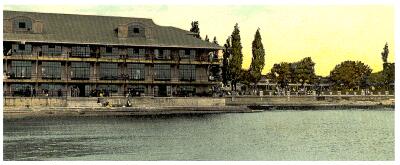
|
| This shows the view from the lake. To the right are various concession buildings. |
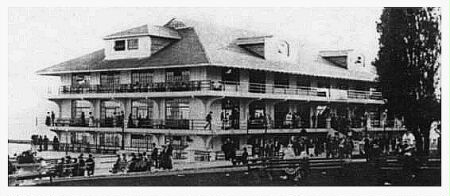
|
Erie Beach Casino Early 1910s |
|
Erie Beach Casino 1970s |
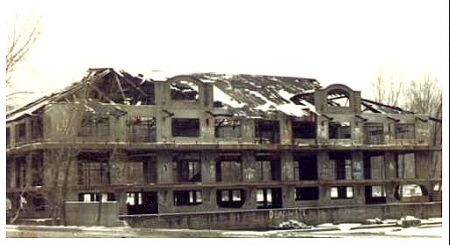
|
| Here's a shot of the remains of The Casino as they were in the 1970s. Its concrete design may be plainly seen. |
In 1915, an immense swimming pool, billed as the "World's Largest", was constructed next to the Casino to augment the less-superior lake swimming area. A children's pool augmented the larger one. By this time there were also bumper cars, an "Old Mill" dark ride (dating from 1910 or brfore), a Traver "Circle Swing", a pony track, a children's pool, a "Razzle Dazzle" (Herschell), and a roller rink.
A March 1917 report said the park had among its attractions a Carousel, Funhouse, Miniature Railroad, and a "Whip" (Mangles).
Other attractions built or installed during the last two decades of the park's existence were a 3500-seat stadium that brought in major acts, a zoo, and a small airport with daily flights to & from Niagara Falls. A Traver "Tumble Bug" was aquired sometime from 1926 (the year of its introduction) onward. Because of the confusion regarding the park's first two roller coasters, as discussed earlier, the stadium erection date is in contention. If the "Figure 8" only lasted until 1909, the stadium was built in the 19-0s; if it lasted longer, the stadium would not have been built until 1910 or within a few years of that date. Newspaper accounts mention the stadium as early as 1910, so it is no newer than at least that season.
|
The Stadium 1910s |

|
| This shows the stadium entrance. At the left is the ticket window for air excursions. The middle sign is for Bowling and Billiards. |

|
The Stadium Interior 1914 or Earlier |
| Crowds pack the stadium in this view that looks towards the entrance. Its towers may be seen at Center Left. To the right is the Scenic Railway structure. |
Sometime in this period The "Blue Streak" coaster opened. The designer of this ride is in contention, with some sources citing John Miller. However, Joe Heflin's documented list attributes it to Canadian-born designer Fred Church. The year it opened is also in contention. I have seen 1911, 1921, and 1928. I think the 1911 date is confused with Miller's "Scenic Railway", which opened in 1910, and the 1928 date is confused with Schmeck's "Wildcat" coaster, which may also be part of the reason for the designer confusion. Tim Wagner of Fairport, New York feels that 1921 was too late for a side-friction coaster, and that it was likely built to compete with Crystal Beach within a year or two after that park's "Giant" (1916). I feel it was a Church ride and it opened sometime after World War I. Victor Canfield's research pegs it at 1919. The ride lasted until at least 1928, but may have also been there until the park's 1930 demise.
The park also at this time had a kiddie area. It included an enclosed, six-bench ferris wheel, a carousel, and "Fairy Swings".
Patronage began to fall off in the mid 1920s due to competition from Crystal Beach. Even the lure of alcohol to dry Americans whose government had outlawed alcohol during this period, and the opening of the nearby Peace Bridge from Canada to The United States in 1927 was not enough to stem the decline. A new owner, who bought the park after Bardol's death in 1925, did try to compete though. He spent $300,000 for the 1927 season. This included a new 60,000 concrete dock for the ferries, a new pony track in the picnic grove, a new $50,000 "Mill Chute" ride with a 365-meter slide into the water, new equipment for the swimming pool and children's playground, and new furnishings for the hotel. An "Electric Penny" game is also mentioned as operating in at least 1929.
For entertainment, the park booked nationally-known bands for its dance hall. Canada's most famous big band was "Guy Lombardo and his Royal Canadians". Their contract at this park started in 1924. The 1927 season also saw Erie Beach Park host The Diamond Jubilee, a celebration of Canadian Confederation which had occurred in 1867. Members of the Ontario Parliament and U.S. Congressmen attended the ceremonies.
|
Erie Beach Walkway 1920s 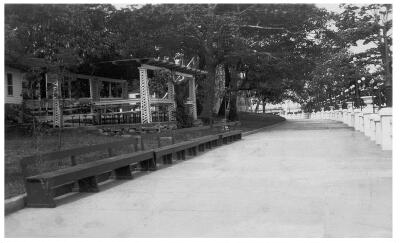 |
In 1928 Herb Schmeck and The Philadelphia Toboggan Company built coaster #76, The "Wildcat". It was a double figure `8' with a 540-degree spiral at one end and a large elevated swoop turn at the opposite extreme. It was to last only three seasons because the park closed in 1930. The ride was apparently dismantled but no reference has surfaced as to whether it was ever re-erected elsewhere or not.
Next to the coaster was an attraction called "Speedway" (Parker?), but no other information exists as to whether it was the popular game of the era, or if it was a go-cart or U-drive installation. Its facade may be seen in the first "Wildcat" photo below.
|
Shown are the ride's entrance and lifthill. |
Wildcat Late 1920s 
|
|
Wildcat Late 1920s 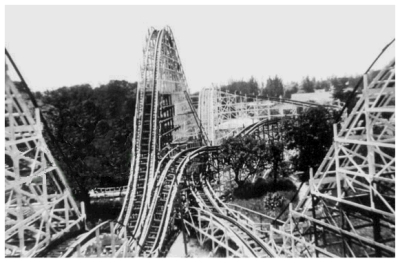
|
The first drop and some of the other hills are seen here. |
| The 540-Degree Spiral |
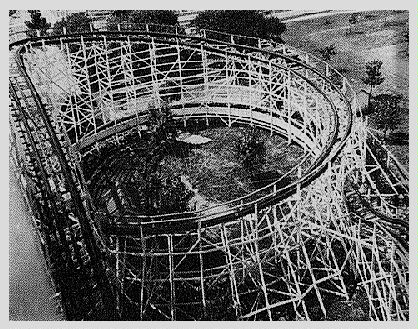
|
In 1929 the park added a new ride called The "Lindy Loop", which sounds like an early version of an Eyerly "Loop-O-Plane". However, Stan Barker, archivist for The National Amusement Park Historical Association, says this ride was not a forerunner of The "Rocket Ships" or "Loop-O-Plane". He cites a 1991 George Siessel article in "At the Park" magazine:
"The `Lindy Loop' (not Looper), a Spillman ride of the mid-1920s and early 30s, was similar to the later Herschell `Looper', but the cars resembled old fashioned sleighs and did not go upside down. Instead of runners, they were mounted on crescent-shaped rails, with the curve down and the ends up. At the top attached to each end, was a rounded canopy. This gave the whole thing the look of two circles or wheels with the sleigh between them. There were eight of these units mounted on a circular track that undulated, as on a `Caterpillar' ride."
"The sleighs were mounted in such a way that they could roll forward and backward on these crescent-shaped rails. As the track moved up and down the hills, the sleighs began rolling back and forth. At maximum speed, depending on passenger weight, they would roll quite a bit, climbing the rails front and back. Passengers had no control over the movement. The action resembled a demented lawn swing on a skateboard."
"Siessel says it was made by Spillman around. 1925... actually, Lindbergh's flight wasn't till 1927, so it would have to be after that." It is possible, that the ride could have come out before Lindbergh's famous flight, but under a different name which was changed after 1927 to capitalise on the event.
Despite the addition of this ride and having 68 picnics booked for June alone, plus attracting people with special dance programs and instruction, Erie Beach could no longer sustain its existence and so ceased operations at the close of Labour Day, September 1st, 1930. The property and assetts were bought by the Crystal Beach owners as a way to stem possible future competition. Some of the attractions that went to Crystal Beach included the miniature train, games, a "Blue Streak" train (which was used on The "Giant" coaster), and other rides. The "Dodgem" bumper car ride went to London, Ontario. It may have been for Springbank Park.
The carousel was sold to Glen Park, New York where it remained until being bouyht by Richard Lohr after that park closed around 1970. He then had New Yorker Vincent Stanley restore the ride over a period of 14 months. At that time, the ride consisted of 34 horses, two chariots, plus one each tiger and lion. Also included was a bulldog riding one one of the horses. It's unknown if any of the remaining flying ponies were still on the ride. Photos in the Skylon Amusement Park article show the restored carousel. In one of them, some of the pole angles appear to not be vertical, thus suggesting that some of the horses may still fly out when the ride turns.
For a time in the mid 1970s, Lohr leased it to the Skylon because its park was indoors where the ride would not be subject to weather. Its current location is not presently known.
As for Erie Beach, The Sandfly Express ceased operations and its rolling stock was eventually sold for scrap to be cut up during World War II. The boardwalk, Casino and the hotel remained. The latter burned in 1935 and was not replaced, and the Casino was eventually abandoned. In 1975 or 76, its remains were demolished as being unsafe. As of a number of years ago, remnants of the park were still visible in the form of ride footings and the partial foundations of the swimming pool and roller rink. Some of the "Old Mill" troughs were still to be found a decade or more ago grown up by trees, but it's not known if they still exist.
Peter Warwick of St.Catharines, Ontario said in 2004: "There is a new development proposed for the area in back of the ruins. The remnants are fascinating to see, especially when you consider what was once there. I find it quite attractive as they're in amongst trees. A section of the Fort Erie - Port Colborne Friendship Trail (multi-use trail) is to be built through the area. During the summer I often bicycle through this area on long distance rides."
(*) For world's fair information, see the CEC's World's Fair sections
under Books, and at The Exhibition
Grounds on The Midway.
Here's another look at
Erie Beach Park
|
My thanks to Tim Covell of Ottawa, Ontario for sending information
as originally written by Ed Lanthier on Erie Beach Park. Thanks also to Rose Jankowiak of Cheektowaga, New York for the carousel information. A thankyou to Tim Wagner of Fairport, New York for additional information and an Erie Beach time line. Thanks to Brian Westhouse of Rexdale, Ontario for information on the Fort Erie Ferry Terminal Railway Company and its acquisition of locomotives and cars. Thanks also to Brian for many of the postcard scans seen here. Victor Canfield provided additional information from his research. My thanks to him for sharing. See Victor's webpage: -Roller Coaster and Amusement Rides. |
Return to the
Closed Canadian Parks Index
